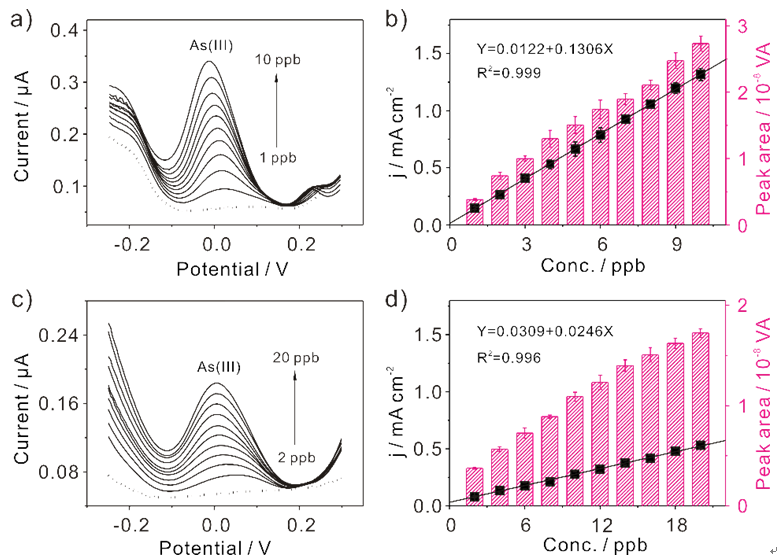Electrochemical analytical tools are widely applied to As(III) detection and abundant achievements have been made. However, to realize the accurate and reliable detection of trace As(III) in groundwater perfectly, the sensitivity and the limit of detection need to be further improved. Furthermore, the popular gold-based electrodes are operated in strongly acidic media, which causes problems of producing toxic arsine gas, generating interference from H2 evolution and unsafety for transport. Detection of As(III) without interference in the real sample is a challenging task, and particularly Cu(II) is a major interference in the detection of As(III). Hence, analytical challenge for As(III) determination is to seek an reliable platform to realize the sensitive detection of ppb or sub-ppb levels of As(III) with interference-free from common coexisting substances under the mild condition.
Recently, a study team led by Prof. LIU Jinhuai and Prof. HUANG Xingjiu in Institute of Intelligent Machines (IIM), Hefei Institutes of Physical Science, explored the enhanced electrochemical sensing arsenic(III) using amino-functionalized graphene oxide decorated gold microelectrode. The paper is accepted for publication by Sensors and Actuators B: Chemical.(http://www.sciencedirect.com/science/journal/09254005)
In this work, a reliable, high sensitive and excellent anti-interference electrochemical sensing As(III) with amino-functionalized graphene oxide(NH2-GO) decorated gold (Au) microelectrode is developed in mild media with square wave anodic stripping voltammeter (SWASV). Taking advantage of the synergy between the strong absorption capability of NH2-GO and the excellent electrocatalytic ability of Au microwire, the NH2-GO modified Au microelectrode shows the enhanced electrochemical performance toward As(III). Under the optimized conditions, the limit of detection (3σ method) toward As(III) is 0.162 ppb with a sensitivity of 130.631 µA ppb−1cm−2. No obvious interference from other commonly coexisting ions on the determination of As(III) is observed. Notably, the possible mechanism of the enhanced stripping signal is preliminarily explored by using X-ray photoelectron spectroscopy (XPS) and X-ray absorption near edge structure (XANES) techniques. XPS results quantificationally reveal the largest amount of adsorbed As(III) on the NH2-GO, and high-resolution XPS and XANES results confirm that the adsorbed As(III) onto the NH2-GO maintains the original As(III) oxidation state, which is beneficial to the sensitive and accurate analysis of As(III). Moreover, the analytical application of the raised means on the detection of As(III) in Xingwangzhuang Village groundwater, Inner Mongolia, has been successfully verified. Findings of this work provide a new perspective on the development of novel sensing materials for the analysis of toxic ions based on the concept of adsorbent-assisted electrochemical analytical.
This work is supported by the National Natural Science Foundation of China (21377131, U1532123, 61474122, 21475133,21277146, and 61573334). The authors thank Shanghai Synchrotron Radiation Facility (beam line BL14W1) for providing measurement time. X.-J. Huang acknowledges the Chinese Academy of Sciences (CAS) Interdisciplinary Innovation Team of the Chinese Academy of Sciences, China, for financial support.

